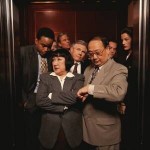I was in a lift recently with four other individuals. Four of us stood in the corners, and the fifth bang in the middle. If you could have looked down from the top, it would have given a perfect image of the 5 dots on a die face.
In short, unless we are actually with someone and engaged in a conversation. we keep the maximum distance possible from the other people in the lift, and avoid eye contact or any conduct that might be deemed perverse or perverted. Ah, but the rules of the game do make it acceptable to have a surreptitiously glance at your fellow passengers, their clothes, what they are carrying, maybe what they are doing, but never let them catch you at it.
To be seen looking at them is taboo at any time, unless you choose to engage a fellow passenger in polite conversation. This is acceptable if, for example, you are the only two people in the lift, and your comments are restricted to the weather, the slowness of the lift or something equally benign and pointless, though sometimes it will cause distress and would be out of the question if anybody else were present but apparently excluded from the conversation – playing gooseberry in a situation with potential for embarrassment would be a social curse beyond all measure. Of course, conversation is easier if you happen to know the person concerned, in which case it could be a polite enquiry about partner/children/work/holidays, an inane remark about how long it is since you met, or if you work together a detailed technical point about the Hudson client file, for example, to which anyone else in the lift will simply shut their ears.
So what other rules apply in this dangerous anthropological game of chance? The first is successfully to negotiate an entrance, tricky given that you have to be sure everyone has left before you commence boarding and then you may have to do a rapid count to ensure the number of people in the lift is within the limits, and that their combined weight does not exceed the maximum. In America, the high preponderance of walking flesh buckets probably means the maximum is restricted to one person, but inevitably the tubbiest passenger will suffer suspicious looks.
But it is much worse if you happen to be carrying a bulky object. Inevitably every other person present will exhibit the worse kinds of body language to display their resentment of this intrusion, and may even look daggers in your general direction. Worse is the baby carriage, push-chair or similar, since it takes up 90% of the space and forces other lift passengers into one another’s comfort zones, but the absolute cardinal sin is to have a push chair loaded with shopping or anything other than the infant for which it is intended. I’m quite sure people have been lynched for less.
Next is the button pressing. There is no clear etiquette here, so you may lunge at the control panel to check whether your floor is already selected, and press the button if not – providing you don’t actually touch anyone in the process. However, to circumvent that risk, the person closest to the panel may choose to ask, “what floor?,” to which you need only reply with a number and a polite “thank you.”
Then comes the hiatus: that gap while the electrics and engineering spring into motion, and the lift whirrs into motion. Like being trapped in an aeroplane but without the food, drinks and movies, you wait. And wait. Hard though it is and much though you may want to rush out screaming, you stay patient until the next stop.
Then you need to worry about the exit feint. This happens when the lift stops at an intervening floor. Your assumption is always that it has made a bee-line for your floor, so when the lift stops your legs automatically inch you towards the exit. But, within a fraction of a second you realise that it’s not your floor. To avoid further social humiliation, you engage in a small ritual dance, a sort of soft shoe shuffle, to make people think you were just changing position for comfort, not actually departing early by mistake.
But finally you do get to your floor and get out into the relative safety and wide-open spaces of your floor. Your relief is partly to escape the close proximity to other people, the claustrophobic environment, and relative lack of oxygen, but also that the mother and father of all nightmare scenarios has been avoided: the lift jam.
We’ve all been there at some point – the lift becomes stuck between floors, which, in-keeping with sod’s law, only happens when the car is full (did you miscalculate the numbers, or did it the 200kg man mountain in the corner cause it to stop? More dirty looks…) Nervous whistling may follow.
Now being stuck is only a serious problem for claustrophobics and those who simply can’t wait (there is always one who is late for some appointment.) Most Brits will press the emergency call button and wait stoically for help to arrive, which inevitable takes five times longer than even the slowest estimate. But what everybody is thinking but dare not admit is that the disaster movie scenario, where the lift suddenly judders, then goes into free fall down to the bottom of the shaft, where rescue workers will later piece together the bloodied limbs and torsos.
We dare not admit to such thoughts, but they are always present, like the proverbial elephant in the room. So we wait and wait until the engineer arrives, and we are safely conveyed to whichever floor is closest, from there to resume the journey by stairs, which, had we chosen that route in the first place, may have saved us an inordinate delay. But then, in movies the other possible ending would be a gun man on the roof of the car, spraying everyone with bullets, so maybe we also thank our lucky stars.
So just remember the level of sophistication required in your thought processes every time you enter a lift. And break as many rules as you possibly can (evil laughter)!!!
PS. This article puts an interesting perspective on lift behaviour!





Brilliant. Love the tongue in cheek approach.
Please reread – just edited slightly and added a little more!
Even better!!!!
I laugh at the part of the torsos and the last two paragraphs were perfect. I regret that you couldn´t hear my laugh because of your humourous point of view.